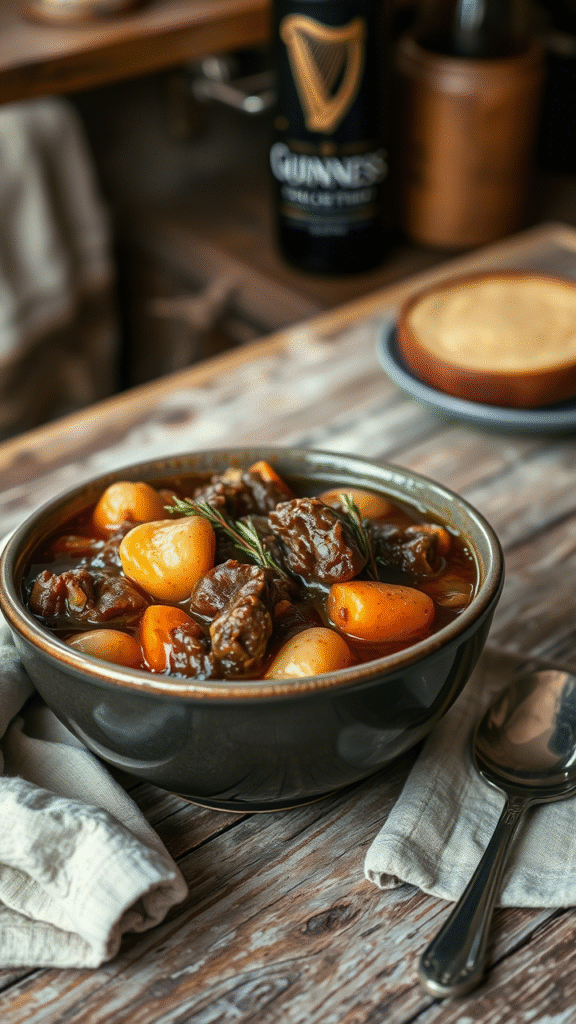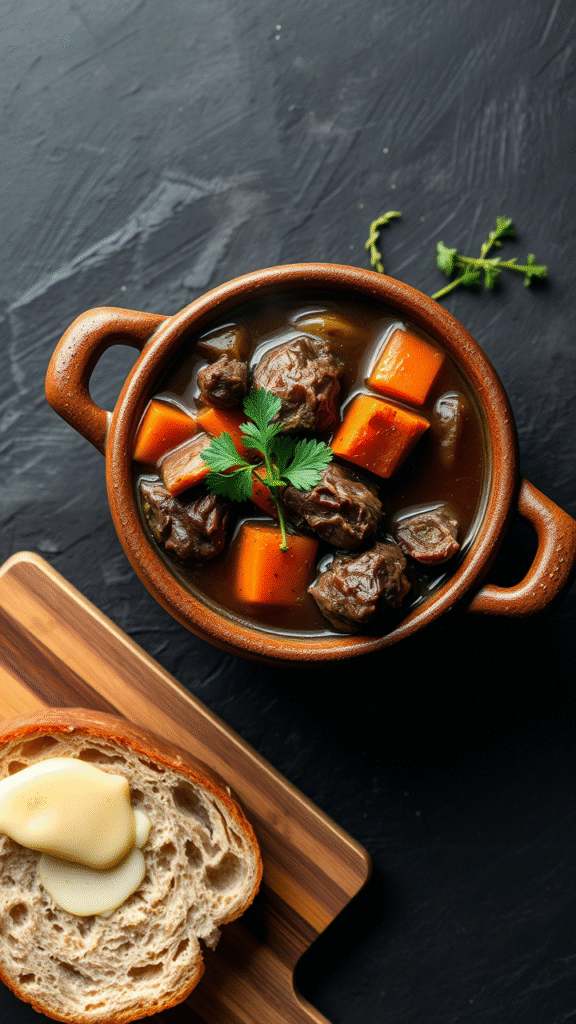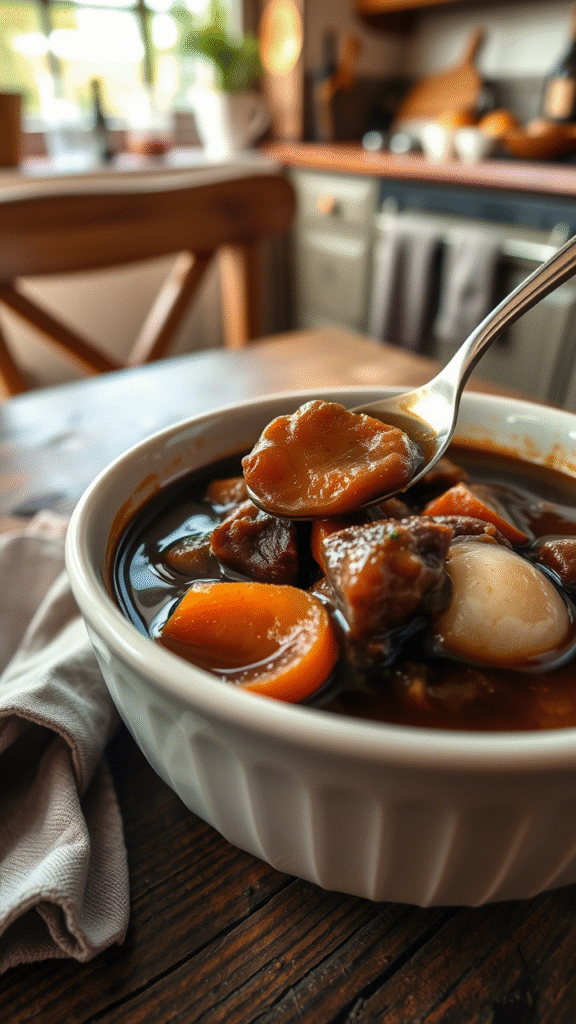It was a bitter Tuesday in January when I first tasted a proper Guinness beef stew. Not one of those half-hearted, watery imitations served over limp mash. I mean the real deal—thick, rich, dark as night, and so soul-satisfying it could probably mend a divorce. A grizzled old Irish cook served it to me in a pub outside Galway. He said, “If the spoon don’t stand up in it, it ain’t ready.” That moment changed how I saw stew forever.
Guinness beef stew isn’t just a dish. It’s a slow-simmered declaration of what comfort food should be. And let’s get something straight from the jump—this isn’t just chuck beef floating in beer. This is a centuries-honed balancing act between bitter and sweet, dark and bright, rich and humble. The kind of dish that improves your mood and your week, all in one ladle.
This article is for serious cooks. If you want to truly master Guinness beef stew—not just make it, but understand it—this is your roadmap.
What Makes Guinness Beef Stew Special?
At its core, Guinness stew is a rustic braise—nothing fancy. But the genius lies in its simplicity. Guinness Draught (yes, the nitro-can or draft-pour version, not Extra Stout) gives it that unmistakable bitter-sweetness. It’s not just a beer stew. It’s the beer stew.
Long, slow cooking extracts deep flavor from beef, onions, and root veg. Browning, deglazing, and layering flavors step by step transforms basic ingredients into something greater than the sum of its parts. Also, the Irish don’t mess around with stew—this is their heritage in a bowl.
Ingredients & Substitutions

Let’s go shopping, yeah? But smart.
Beef chuck (2.5 lbs / 1.2 kg) – The king cut for stew. Tough at first, but melts into buttery softness with time. You want some marbling. If you can’t get chuck, brisket or shin will do the trick. Avoid lean stewing beef—it’s a one-way ticket to drysville.
All-purpose flour (for dredging) – Helps the meat brown and thickens the stew. You can skip it if you want gluten-free; just reduce liquid a little more.
Kosher salt & freshly ground black pepper – Season generously and early. Don’t be shy.
Olive oil or beef tallow (2–3 tbsp) – For browning. Tallow adds richness, olive oil works fine. Butter burns too fast here, so don’t.
Yellow onions (2 medium, chopped) – Caramelize them well. This ain’t just for sweetness; it’s foundational flavor.
Carrots (3 large, cut chunky) – Not coins. Give them some heft so they don’t vanish by the end.
Parsnips (optional, 2) – Brings a slightly nutty sweetness. Swap with turnips or leave out.
Celery (2 stalks, rough chop) – Adds background flavor, not crunch.
Garlic (4 cloves, minced) – Add halfway through browning onions. Burned garlic ruins everything.
Tomato paste (2 tbsp) – Umami bomb. Cook it out for a minute or two—don’t leave it raw.
Guinness Draught (1 pint / 500ml) – Important: use Draught, not Extra Stout. The draught’s creamy, soft bitterness is key. Extra Stout is sharper and can overpower. If you’re alcohol-free, try a mix of malt vinegar and strong beef stock, but it’s not quite the same.
Beef stock (2 cups / 500ml) – Homemade is gold. Otherwise, use a low-sodium one and build flavor slowly.
Fresh thyme (a few sprigs) + bay leaves (2) – Dried thyme’s okay in a pinch, but half the quantity.
Worcestershire sauce (1 tbsp) – Optional, but adds depth. It’s that secret “why is this so good?” flavor.
Potatoes (waxy, like Yukon Gold, 3–4 medium) – Add near the end so they don’t go mushy. Floury potatoes will fall apart.
Flat-leaf parsley (for garnish) – Optional but brightens things. Adds contrast.
Step-by-Step Instructions

Let’s cook slow and cook smart.
1. Dredge the beef.
Toss beef chunks in seasoned flour. Not caked—just enough to coat. Shake off excess. This helps with browning and gives you that nice stew body later. Don’t skip it unless you have a reason.
2. Sear in batches.
Heat oil in a heavy Dutch oven or wide pot. Brown beef in small batches so it actually browns, not steams. Get that deep mahogany crust—it’s where all the umami lives.
3. Pull the meat, sauté the veg.
Once beef is browned, set it aside. In the same pot, add onions. Cook low and slow until they go golden. Then garlic. Then tomato paste. Stir and toast everything until it smells like a warm Irish pub kitchen at closing time.
4. Deglaze with Guinness.
Pour in half the Guinness. Scrape up all the brown bits—that’s flavor gold. Let it bubble for 2–3 minutes to burn off the harsh alcohol.
5. Add stock, herbs, beef.
Return beef to the pot. Add stock, bay leaves, thyme, and remaining Guinness. Bring to a bare simmer.
6. Low and slow.
Cover and cook at low heat—either stovetop or 325°F (160°C) oven—for 2 to 2.5 hours. Stir occasionally. Don’t boil it. Boiling makes the meat tough. It’s not a jacuzzi, it’s a spa day.
7. Add veg halfway.
Toss in carrots and potatoes at the 1.5-hour mark. They should hold shape but be spoon-tender by the end.
8. Final taste check.
Remove herbs. Taste. Add a splash of Worcestershire or a pinch of sugar if it needs balance. Salt and pepper, always.
9. Let it rest.
Stew’s better 20 minutes later. Even better the next day. This isn’t fast food, it’s legacy food.
Cooking Techniques & Science
Here’s why we do what we do.
Browning is flavor. That deep, almost-burnt edge on the meat? Maillard reaction. It makes things taste roasty, meaty, complex. No browning = flat stew.
Low, moist heat breaks down collagen. Chuck and shin are full of connective tissue. That’s why they’re tough raw, but turn meltingly soft after hours of slow braising. It’s not magic—it’s collagen turning to gelatin. Makes the stew luscious, silky.
Guinness is bitter—balance it.
The beer brings depth but needs sweetness to round it. Caramelized onions, carrots, even that smidge of tomato paste—all counteract the bitter edge. Taste it raw vs. cooked, and you’ll get it.
Thickening, naturally.
That flour on the beef? It thickens the stew as it cooks. Don’t be tempted to add a cornstarch slurry—this isn’t a Chinese takeout sauce.
Why a Dutch oven?
Thick walls, even heat, good lid. Keeps the cooking steady and slow. A thin pot gives you scorched bottoms and sad stew.
Serving & Pairing Suggestions

Ladle it into deep bowls. Garnish with chopped parsley if you’re feeling fancy, or don’t—it’s not about looks. Stew’s about heart.
Sides?
Soda bread is the classic. Buttery mash works too, as does a slab of crusty sourdough. Avoid sweet cornbread—wrong continent, wrong vibe.
Drinks?
More Guinness, obviously. Or a dry Irish cider for something lighter. A neat whiskey with dessert never hurt either.
For dessert, go dark and comforting: sticky toffee pudding, or something as unapologetically rich as the stew itself.
Conclusion
Guinness beef stew is the sort of dish you earn. It’s not fussy, but it demands time and care. It rewards the patient cook with something far greater than its parts—a dish with roots, history, and the kind of flavor you can feel in your bones.
Make it when you need warmth. Make it when you’ve got friends over and want to feed them like family. Make it, even if you screw it up a bit the first time. It’s forgiving. Just don’t rush it.
And remember: if the spoon don’t stand up, give it more time.
FAQs
1. Can I use Guinness Extra Stout instead of Draught?
You can, but expect a sharper, more pronounced bitterness. Draught has a smoother, creamier profile that plays nicer with the other ingredients.
2. How do I make this gluten-free?
Use cornstarch or rice flour for dredging, and double-check your beef stock and Guinness alternative. Skip the beer entirely if needed and use a combo of strong beef stock + a splash of balsamic vinegar.
3. Can I make this in a slow cooker?
Yes, after browning the meat and veg. Cook on low for 8–10 hours. Add the potatoes halfway through so they do
4. Why does my stew taste bitter?
Either the Guinness was too strong or not cooked long enough to mellow. Also, burnt garlic or under-caramelized onions can contribute bitterness.
5. What’s the best cut of beef for stew?
Chuck is king for flavor and texture. Brisket and shin are good too, but avoid very lean cuts unless you want dry, tough meat.

Food lover, recipe creator & the heart behind NoshCrafters.com. Olivia shares mouthwatering, easy-to-make dishes that turn everyday meals into unforgettable bites. When she’s not experimenting in the kitchen, she’s busy plating up inspiration for home cooks everywhere.